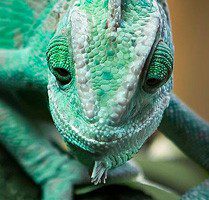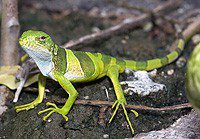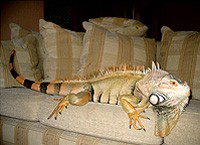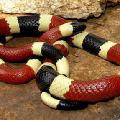
Arizona asp
ASPID ARIZONA (lat. Micruroides euryxanthus) is the smallest snake from the Elipidae (aspid) family, its length is only 40 cm. It consists of alternating black, red and yellow rings. Perhaps the most important feature of the Arizona asp lies not in its bright color, but in the structure of its dental apparatus. On the maxillary bone behind each poisonous fangs (there are two in total) they have another small tooth. However, asps need poisonous teeth not to protect themselves from enemies, but rather to get food. In case of danger, this asp draws air into the lungs and exhales it rhythmically, while making a series of rapidly alternating popping sounds. A small snake produces such unusual sounds to scare away enemies.
Contents
Classification
Kingdom: Animalia (animals)
Type: Chordata
Class: Reptilia (reptiles)
Order: Squamata (scaly)
Suborder: Serpentes (snakes)
Family: Elipidae (aspididae)
Genus: Micruroides (Arizona snake)
Species: Micruroides euryxanthus (Arizona snake)
Inhabitation
Arizona snakes are found in the desert areas of the Southwestern United States and northern Mexico. They can be found both in the dry steppe or desert, and in the humid forest. They can be located not only on the ground, but also climb trees.
Description
In their appearance, almost all representatives of aspid snakes resemble snakes. They have smooth dorsal scales and a slender build. The underside of the asp’s body is covered with wide abdominal scutes. They have symmetrical large shields on their heads, but no zygomatic shield is observed. Most representatives of this family, including the Arizona asp, have a rounded head in front, and are not limited to the neck interception from the body. The pupil of this snake is round. Another feature of the aspids is that the left lung is either completely absent or rudimentary, and there are no vestiges of the pelvis and hind limbs in the skeleton.
The Arizona asp is a miniature snake, one of the smallest in the asp family. It reaches a length of about 40 cm. The color of this snake species is very spectacular, has a contrasting pattern, which consists of a successive alternation of bright red, yellow and black rings.
The Arizona asp is a very dangerous and extremely venomous snake.
Its venomous pairs of teeth sit side by side on the front of a noticeably shortened upper jaw bone. In size, they are noticeably larger than the rest of the non-venomous teeth, besides, they are bent back and have a poisonous channel. Moreover, the anatomical structure of the canal comes from the groove on the front surface of the tooth. These teeth are fixed. Most often, only one of the poisonous teeth is functional, while the second is a replacement in case the snake loses the first, which happens quite often. To replace the lost teeth, new ones grow, so that asps never remain completely without teeth. An important feature of the structure of the dentition of the Arizona asp, in addition to the shortened upper jaw, is the presence of a small tooth behind the poisonous fang on the maxillary bone. This structure is due to the fact that all asps are burrowing snakes.
Despite the small size of the snake, the poison of Arizona asps is very strong and dangerous. It has a pronounced neurotoxic effect. At first, the bite has a small local effect: there is practically no tumor development, no swelling, redness, and extensive external necrosis. But then death comes very quickly. One of the main causes is paralysis of the respiratory center and cardiac arrest.
However, the Arizona asp is not too dangerous for humans: firstly, he loves deserted places and does not crawl near housing, and secondly, snakes of this species rarely use their teeth to protect themselves from humans or large animals. The fact is that their mouth is narrow and does not stretch well, and their teeth are small (in accordance with the size of the snake itself), and the likelihood of an effective bite is extremely small.
Therefore, in case of danger to its life, the Arizona asp can make clapping, rapidly alternating sounds, drawing air into the lungs and exhaling it rhythmically. By this, he warns enemies that it is better not to approach him.
Food
 They usually feed on other animals, swallowing them whole. Moreover, they can eat prey about one and a half times wider than the snake itself. Under natural conditions, the main diet of the Arizona asp, like most slate snakes, is made up of various reptiles – frogs, toads, lizards and other small snakes. As an additional diet, they can eat small mammals, mainly mouse-like rodents, and insects. Arizona asps never hunt for a person or large animals and do not attack first, but if they are disturbed, they will defend themselves and will certainly bite the aggressor.
They usually feed on other animals, swallowing them whole. Moreover, they can eat prey about one and a half times wider than the snake itself. Under natural conditions, the main diet of the Arizona asp, like most slate snakes, is made up of various reptiles – frogs, toads, lizards and other small snakes. As an additional diet, they can eat small mammals, mainly mouse-like rodents, and insects. Arizona asps never hunt for a person or large animals and do not attack first, but if they are disturbed, they will defend themselves and will certainly bite the aggressor.
This small snake is inactive and prefers to wait for its prey in ambush, from there suddenly inflicting a lightning-fast deadly bite. But if the intended victim managed to dodge the first throw of the asp, he can rush in pursuit. But this occupation quickly bothers the snake, and after a couple of meters it stops the pursuit and again lurks in ambush.
Additionally
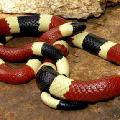 The Arizona asp is considered a very dangerous venomous snake. Its venom is predominantly neurotoxic. When bitten, a person feels a sharp pain, but the external impact is minimal – usually there is no swelling, bleeding, redness and necrosis. Within half an hour, general symptoms of poisoning develop: nausea, weakness, headache, drowsiness, muscle weakness, and occasionally vomiting. Neurological symptoms appear later. The fact is that asp venom disrupts the transmission of nerve impulses, blocking also some intracellular enzyme systems. It disrupts the respiration of cells, as a result of which the activity of some vital nerve centers fades. There are phenomena of progressive paralysis and respiratory depression. In a matter of hours, people develop severe muscle weakness, problems with coordination of movements, and an unsteady gait. It all ends with a general ascending paralysis of the motor muscles. Later, paralysis of the respiratory muscles leads to complete cessation of breathing and death.
The Arizona asp is considered a very dangerous venomous snake. Its venom is predominantly neurotoxic. When bitten, a person feels a sharp pain, but the external impact is minimal – usually there is no swelling, bleeding, redness and necrosis. Within half an hour, general symptoms of poisoning develop: nausea, weakness, headache, drowsiness, muscle weakness, and occasionally vomiting. Neurological symptoms appear later. The fact is that asp venom disrupts the transmission of nerve impulses, blocking also some intracellular enzyme systems. It disrupts the respiration of cells, as a result of which the activity of some vital nerve centers fades. There are phenomena of progressive paralysis and respiratory depression. In a matter of hours, people develop severe muscle weakness, problems with coordination of movements, and an unsteady gait. It all ends with a general ascending paralysis of the motor muscles. Later, paralysis of the respiratory muscles leads to complete cessation of breathing and death.
With the bites of the Arizona asp, the correct provision of first aid, first aid, is very important. You can try to squeeze out the poison, but it makes sense to do it immediately, in the first 5 minutes after the bite. Do not apply a tourniquet and pull the injured limb, it is useless and even harmful. Complete immobilization of the affected limb is recommended. Snake venoms spread from the site of injury throughout the body through the lymphatic vessels, and not through the blood vessels. And the outflow of lymph from the limbs depends only on muscle movements. Carrying and transporting bitten by snakes is possible only in a supine position, because. they can not sit or walk – in order to avoid fainting. You can give the patient hot strong tea, coffee or broth to drink. Alcohol should not be taken, because. it promotes the spread of poison throughout the body.
The most dangerous thing about the Arizona asp is that there is no specific antidote for its poison. Therefore, death from bites occurs in 50% of cases.
Sources of
http://www.yadoktor.ru
http://www.zooeco.com
http://www.i-nature.ru
http://animalzone.ru
http://colubrine.ru/
http://dic.academic.ru/
http://base.safework.ru/
http://reptiliy.net/
http://big-snake.narod.ru/
Other names
Sonoran Coralsnake, Arizona coral snake, Sonoran coral snake, Western Coral Snake.
Subspecies
In nature, there are three subspecies of the Arizona asp (Micruroides euryxanthus): the nominative subspecies Micruroides euryxanthus euryxanthus (Kennicott, 1860), the other two are Micruroides euryxanthus australis (Zweifel and Norris, 1955) and Micruroides euryxanthus neglectus (Roze, 1967).
Habitat
All subspecies of the Arizona asp are commonly found in the desert areas of the Southwestern United States and northern Mexico. These small snakes can be found both in the dry steppe or desert, and in the humid forest. All American asps lead a secretive lifestyle: during the day they hide in the litter of fallen leaves, under the roots of trees or burrow into the ground, and at night they go hunting, eating small snakes, lizards, amphibians and rodents. They appear on the surface only during the rainy season or during the breeding season. An important feature of Arizona asps is that, due to their small size, they can be located not only on or under the surface of the earth, but also climb trees. They rarely crawl out to human habitation, which the indigenous people of America are very happy about – death from the bite of the Arizona asp occurs within 8-24 hours, and in the absence of timely assistance, death is inevitable.
Content
The Arizona asp is not too dangerous for humans, but only if they met in natural conditions. In nature, the asp will prefer to crawl away or make threatening sounds and drive the person out of its territory. The maintenance of poisonous snakes in general and the Arizona asp in particular in a home terrarium is highly undesirable and is associated with significant difficulties. Even experienced herpetologists do not risk keeping poisonous snakes at home, which require special conditions of detention. Moreover, the violent death of household members or neighbors from a snakebite falls under Article 109 of the Criminal Code of the Russian Federation “Causing death by negligence”, which is punishable by restriction of liberty for up to three years or imprisonment for the same period.
In addition, venomous snakes do not tolerate captivity well and usually die within a couple of years after capture.
Reproduction
Since the Arizona snake is a rather rare snake species, and given the small number of representatives of this species in zoo collections, their reproduction is poorly understood. It belongs to the egg-laying species of snakes. The mating season for representatives of this species occurs once a year and begins in the spring and continues in the summer. Already at the end of summer, the female brings a clutch of 2-3 eggs. She makes her nest in a pile of fallen leaves or an earthen hole, warming the eggs with her body heat and protecting them from temperature changes and surrounding views. During these periods, the Arizona vipers are very aggressive, and you should not
approach their habitats without extreme necessity, causing a completely natural defensive reaction on their part.



